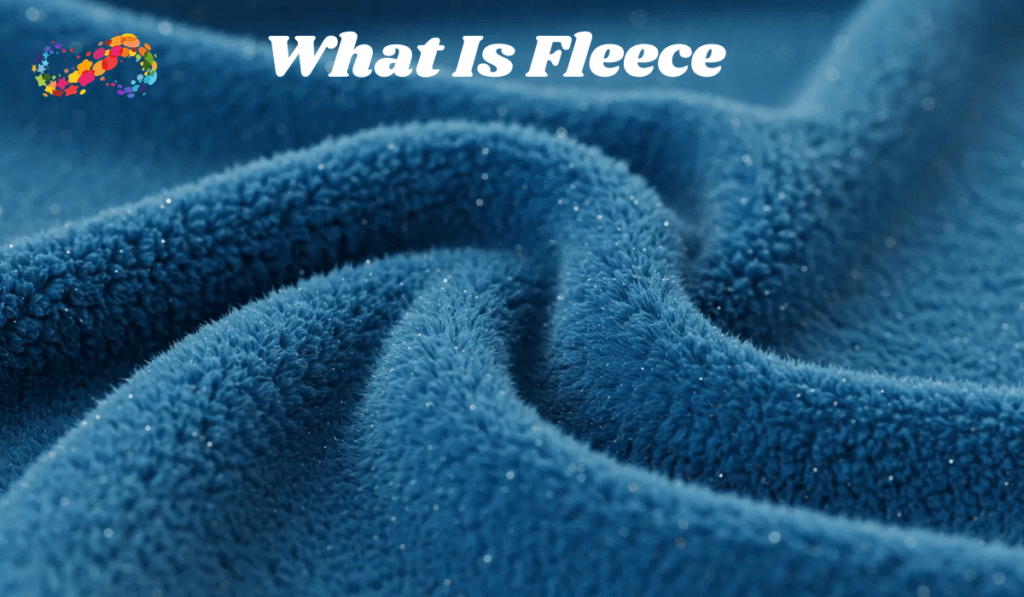A Cozy Memory That Sparks Curiosity
I’ll never forget the first time I curled up under a fleece blanket on a chilly winter night. It felt like a warm embrace, its soft, fuzzy texture wrapping me in comfort like a quiet promise of coziness. That moment got me wondering: what is fleece, exactly? How does this plush, inviting fabric become a go-to for everything from snuggly throws to sturdy outdoor gear? Let’s dive into the world of fleece—its meaning, materials, and the artistry behind its warmth—to discover why it feels like a hug in fabric form.
Defining Fleece: More Than Just a Fabric

At its core, fleece is a synthetic textile crafted to echo the insulating warmth of wool but with a modern, practical spin. What does fleece mean in clothing? The word stretches back to Old English, conjuring images of a sheep’s woolly coat or even the mythical Golden Fleece. Today, fleece fabric is a man-made wonder, typically made from polyester, cherished for its softness, lightweight feel, and endless versatility. Define fleece in 2025, and you’re talking about a fabric that’s just as cozy in a polar fleece pullover as it is in a fleece blanket tossed over your couch.
Unlike its woolly roots, modern fleece is built for real life. It’s quick-drying, tough, and often crafted from recycled materials, making it a favorite for fleece activewear, ladies polar fleece jackets, and even camping fleece material. But to really get what is fleece, we need to dig into the materials that bring it to life.
What Is Fleece Made Of? The Building Blocks of Comfort
When someone asks, what is fleece material made of?, the answer usually begins with polyester. Polyester fleece starts with polyethylene terephthalate (PET), a petroleum-based plastic spun into fine threads. These threads form the backbone of fleece textiles, transformed into that fuzzy, heat-trapping texture we adore. What is fleece material made out of? While polyester is the star, some fleece blends weave in natural fibers like cotton, hemp, or rayon for extra softness or breathability.
For instance, cotton fleece feels silky but might shrink in the wash. Hemp fleece and bamboo fleece lean eco-friendly, while merino wool fleece material adds natural warmth and odor resistance. What’s fleece made out of in greener versions? Recycled fleece, often made from plastic bottles, delivers the same cozy vibe with less environmental impact. Then there’s sherpa fabric, sometimes called berber fleece fabric, which mimics sheepskin with its fluffy, nubby texture, usually crafted from polyester or acrylic blends.
The Craft of Fleece: How It’s Made
Ever wondered what is fleece fabric made? It’s a mix of science and creativity. It starts with liquified polyester pushed through a spinneret—a metal disk with tiny holes—to create fine threads. These are knitted or woven into a base fabric, then brushed with a napper to give that signature fleece texture. How fleece is made involves teasing the fibers to form air pockets that trap warmth, making fleece cloth a stellar insulator. Some types, like plush fleece or sherpa fleece, are brushed more for a thicker, fluffier pile, while French terry fleece stays smoother for a less fuzzy feel.
How is polar fleece fabric made? Polar fleece, born from Malden Mills in 1979, uses a tighter weave for extra warmth. Lightweight polar fleece fabric (under 200 GSM) is great for activewear, while thick polar fleece fabric (300+ GSM) tackles harsh winters. Microfleece material, with its ultra-fine pile, is perfect for lightweight layering. A final shearing step smooths the surface, and some fleece gets a water-repellent finish for outdoor adventures.
Exploring the Types of Fleece: A Fabric for Every Need
Not all fleece is created equal. Different types of fleece fabric serve unique purposes, from lightweight fleece material for cool days to thick fleece material for freezing adventures. Here’s a look at the most popular types of fleece:
Polar Fleece: What is polar fleece material? A dense, double-sided fabric known for warmth and durability, ideal for polar fleece hooded sweatshirts or women’s polar fleece jackets. It resists water and pilling.
Microfleece: What is microfleece material? Thin and lightweight (under 200 GSM), it’s breathable and perfect for fleece activewear or base layers in mild weather.
Sherpa Fleece: Sherpa fabric definition? A fluffy, sheepskin-like texture on one side, often seen in sherpa blanket photos or jacket linings for cozy warmth.
Cotton Fleece: Softer and more breathable, used in fleece cotton sweatshirts or baby clothes, though it may shrink.
French Terry Fleece: What is French terry fleece? Smooth on the outside with looped insides, great for fleece pants or loungewear.
Plush Fleece: What is plush fleece? Velvety and luxurious, perfect for fleece blankets or winter apparel.
Coral Fleece: What is coral fleece fabric? Silky and lightweight, often used in blanket fabric types for a smooth, soft touch.
Berber Fleece: Similar to sherpa, it’s thick and plush, used in jackets or throws.
Lycra Spandex Fleece: Stretchy and form-fitting, ideal for performance gear like fleece leggings.
What is the difference between plush fleece and fleece? Plush fleece boasts a deeper, softer pile, while standard fleece is more practical. Polyester fleece vs fleece? Most fleece is polyester-based, but blends differ in texture and purpose.
Fleece vs. Other Fabrics: A Side-by-Side Look
To understand what fleece is, comparing it to other fabrics helps. Here’s a table breaking down fleece vs cotton, fleece vs wool, and polar fleece vs microfleece:
| Fabric | Warmth | Breathability | Weight | Care | Eco-Friendliness |
|---|---|---|---|---|---|
| Fleece | High (traps air) | Moderate to high | Lightweight | Machine washable, quick-drying | Varies (recycled options) |
| Cotton | Moderate | High | Heavier | May shrink, absorbs water | Natural, biodegradable |
| Wool | Very high (insulates when wet) | High | Heavier | Requires special care | Natural, biodegradable |
| Polar Fleece | High | Moderate | Medium to heavy | Durable, resists pilling | Synthetic, recyclable |
| Microfleece | Moderate | High | Very lightweight | Soft, flexible | Synthetic, recyclable |
Is fleece softer than cotton? Often, yes, thanks to its brushed pile, though cotton fleece can match its softness. Wool vs polar fleece? Wool is heavier and sometimes itchy but insulates even when wet, while polar fleece is lighter and easier to care for. Non-fleece vs fleece? Fabrics like nylon or silk miss fleece’s fuzzy warmth but may offer smoothness or wind resistance.
Fleece in Our Lives: A Symbol of Comfort
Fleece is more than just fabric—it’s a feeling. What does fleece look like? Picture a fuzzy cheetah fabric or a Bella Canvas sponge fleece hoodie—soft, welcoming, and endlessly adaptable. From western fleece material in rugged outerwear to pink fleece material for fun crafts, fleece fits every style and need. It’s the go-to for fleece ideas projects like no-sew tie blankets or things to make out of fleece, like scarves, pet beds, or fleece printed fabric for home decor.
Where does fleece come from? Its modern form took shape in the 1970s when Malden Mills invented polar fleece fabric, transforming outdoor apparel. Patagonia’s embrace made it a favorite for hikers, skiers, and cozy-home lovers. Is fleece fabric good for winter? Without a doubt—its insulating magic shines in fleece camping fabric, polar fleece pullovers, or fleece blanket material.
Caring for Your Fleece: Tips for Longevity
How to wash fleece fabric? Most fleece is machine washable in cold water on a gentle cycle. Can you iron fleece fabric? Nope—high heat can melt or shrink it, so can fleece be ironed? Stick to air-drying or low-heat tumbling. Skip fabric softeners to avoid pilling, and wash separately to cut down on lint. Is fleece breathable? Yes, especially microfleece and French terry fleece, though heavier types like sherpa fleece prioritize warmth over airflow.
Is Fleece Sustainable? The Environmental Angle
Is fleece a natural fiber? No, is fleece synthetic? Most fleece is polyester-based, made from petroleum, which raises concerns about microplastic shedding during washing. But recycled fleece, crafted from plastic bottles, offers a more planet-friendly choice. Fleece and polyester dominate, but natural blends like wool fleece material or cotton fleece appeal to eco-conscious folks. Synthetic fleece is vegan, unlike wool, making it a cruelty-free pick.
See more Sabrina Carpenter Hair: Styles, Colors, and the Looks That Shaped Her Journey
Fleece as Everyday Magic
Fleece is the fabric of memories—snuggling in a fleece blanket for movie night, zipping into a ladies polar fleece jacket for a brisk hike, or crafting a sherpa blanket as a heartfelt gift. Whether you’re buying fleece fabric at Joann fleece material for a DIY project or choosing lightweight fleece material for activewear, fleece brings warmth and practicality. It’s a fabric that feels like home, no matter where you are.
Your Fleece Questions Answered
What is a fleece blanket made of?
Most fleece blankets are made from polyester, often recycled, with a brushed pile for softness. Some blend in cotton or rayon for breathability.
Is fleece soft?
Absolutely, fleece fabric is loved for its plush, fuzzy texture, especially plush fleece or sherpa fleece, which feel indulgent.
Is fleece wool?
No, fleece is typically synthetic (polyester), unlike wool, a natural fiber from sheep. Wool fleece material exists but is less common.
Can I iron fleece?
No, fleece shouldn’t be ironed, as heat can melt or shrink it. Air-dry or use low heat to keep it in shape.
Is fleece breathable?
Yes, particularly microfleece and French terry fleece. Heavier types like polar fleece focus more on warmth.
What are the uses of fleece?
Fleece shines in jackets, blankets, activewear, scarves, and crafts like tie blankets. It’s ideal for winter and home decor.
Is fleece synthetic or natural?
Most fleece is synthetic (polyester), but blends with cotton or wool offer natural options. Recycled fleece is more eco-friendly.
What’s the difference in fleece fabric types?
Polar fleece is warm and dense, microfleece is lightweight, sherpa fleece is fluffy, and French terry fleece is smooth.
How do I care for fleece?
Wash fleece in cold water, avoid fabric softeners, and air-dry or use low heat to prevent pilling or damage.

